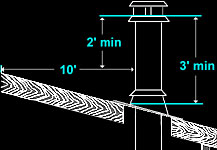 The easiest way to provide exhaust venting for a woodstove in a house that doesn't already have an unused masonry flue is to install a
manufactured chimney. The diagram above shows three typical manufactured chimney installations. The chimney components are shown in white,
while the connector pipe that runs from the woodstove to the chimney is blue. The easiest way to provide exhaust venting for a woodstove in a house that doesn't already have an unused masonry flue is to install a
manufactured chimney. The diagram above shows three typical manufactured chimney installations. The chimney components are shown in white,
while the connector pipe that runs from the woodstove to the chimney is blue.
The insulated stainless steel chimney pipe used in woodstove installations must carry a "Class A" safety listing. Chimney pipe is of double-wall or
triple-wall construction, with solid pack and/or trapped-air insulation between the layers. A third type of manufactured chimney, called "Air Cooled"
chimney, is designed for use with open fireplaces only, and should never be used to vent airtight woodstoves.
There are two types of stovepipe that may be used to connect a woodstove to its chimney. Single wall connector pipe requires 18" clearance to
combustibles, while double-wall (shielded) connector pipe requires only 6" clearance, and may also reduce the woodstove clearance requirements.
Connector pipe may not be used to penetrate a wall, ceiling or roof. Connector pipe may not be used outside: insulated chimney pipe keeps the
wood exhaust from cooling prematurely, preventing loss of updraft and excessive creosote formation.
The bottom of the chimney pipe must extend at least 4" into the room for tee and flat ceiling installations, and far enough below a pitched ceiling to
provide minimum clearance for the connector pipe, measured in a straight horizontal line to the the pitched ceiling ( or nearest combustible surface
).
 |
The top of the chimney must extend upward to a point at least 3 feet above the roof on the high side,
and two feet above any part of the roof within ten feet. If the peak of the roof is within ten feet, the
chimney must extend two feet above it; if the peak is farther away, the chimney must extend two feet
above the point on the roof that can be reached with a ten-foot long horizontal line. If more than five
feet of chimney pipe extends above the roof penetration point, a roof brace must be installed.
|
Tee chimneys ( through a sidewall and then up ) provide the least amount of updraft, due to the necessity of a horizontal section and the exposure of
more chimney to the cooling effect of outdoor temperatures. They are also the most expensive option, as more lengths of chimney are required, and
the tee, tee support and wall pass-through parts must be added to complete the installation. Tee chimneys are generally used only when it is
impractical or impossible to vent straight up.
In installations where the chimney extends through a second story room above the ceiling, the chimney pipe must be framed in and sheetrocked
where it passes through the upstairs living space.
If ceiling and/or roof joists occupy the space directly above the exhaust collar on the woodstove, offsets may be used in the chimney pipe or
connector pipe. Chimney offsets are achieved using a pair of 15 or 30 degree chimney elbows, while connector pipe offsets are usually fixed at 45
degrees. The length of pipe used between the offset and the return establishes the amount of offset achieved. Adjustable connector pipe elbows
should not be used in airtight woodstove installations, as the adjustable joints can allow liquid creosote to leak out.
Copyright © 1996 - 2019 The Chimney Sweep, Inc.
|


